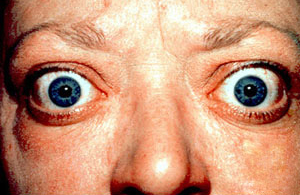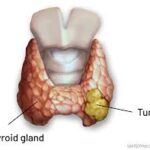Thyroid Eye Disease (TED), also referred to as thyroid orbitopathy or Graves’ orbitopathy, is an autoimmune inflammatory condition affecting the tissues around the eyes. Commonly associated with hyperthyroidism, particularly Graves’ disease, TED may also occur in euthyroid or hypothyroid individuals. This disorder can lead to significant ocular discomfort, vision impairment, and disfigurement if left untreated.

Understanding the Link Between Thyroid Disorders and Eye Health
TED arises when the immune system mistakenly attacks the tissues behind the eyes, including muscles and fat, triggering inflammation and tissue remodeling. Most patients with TED have Graves’ disease, though it can also occur in Hashimoto’s thyroiditis.
Key Pathophysiological Mechanism
- Autoantibodies, especially thyroid-stimulating immunoglobulins (TSIs), target the thyrotropin receptor (TSHR) and IGF-1 receptor in orbital fibroblasts.
- This results in:
- Inflammatory cytokine release
- Adipogenesis (fat cell formation)
- Fibrosis of extraocular muscles
Symptoms and Early Warning Signs of Thyroid Eye Disease
Recognizing the symptoms early is essential for managing TED effectively.
Common Symptoms:
- Proptosis (bulging eyes)
- Dry, gritty, or watery eyes
- Redness and swelling
- Eyelid retraction
- Double vision (diplopia)
- Eye pain or pressure
- Sensitivity to light (photophobia)
- Vision loss in severe cases
Stages of Thyroid Eye Disease
TED typically progresses through two phases: an active (inflammatory) phase followed by an inactive (fibrotic) phase.
- Active Phase: Rapid inflammation, symptoms worsen over weeks to months.
- Inactive Phase: Inflammation subsides; residual effects remain.
Risk Factors and Triggers
Several factors contribute to the development and exacerbation of TED:
- Graves’ disease
- Smoking – most significant modifiable risk factor
- Female gender – more common in women
- Radioactive iodine (RAI) therapy
- High levels of TSHR antibodies
- Poorly controlled thyroid hormone levels
Diagnostic Process for Thyroid Eye Disease
Early diagnosis is essential to prevent permanent damage.
Clinical Evaluation:
- Visual acuity and field testing
- Eyelid and eye movement examination
- Exophthalmometry to measure eye protrusion
Imaging Techniques:
- Orbital CT scan or MRI to assess muscle enlargement, fat expansion, and optic nerve compression
Blood Tests:
- TSH, Free T4, T3
- TSI and TRAb antibodies for autoimmune confirmation
Treatment Options for Thyroid Eye Disease
Management strategies depend on the disease phase and severity. A multidisciplinary approach involving endocrinologists and ophthalmologists is critical.
1. Medical Management (Primarily for Active Phase)
Corticosteroids
- IV methylprednisolone preferred over oral for severe inflammation
Immunomodulators
- Teprotumumab – FDA-approved IGF-1R inhibitor showing remarkable improvement in proptosis and inflammation
- Rituximab – targets B-cells (used in select cases)
Radiotherapy
- Orbital radiation helps reduce inflammation in moderate-to-severe active TED
2. Supportive Measures
- Artificial tears for dryness
- Elevate head while sleeping
- Selenium supplements (may benefit mild TED)
- Smoking cessation is critical
3. Surgical Interventions (Primarily for Inactive Phase)
Orbital Decompression
- Removes bone/fat to reduce proptosis and relieve optic nerve compression
Strabismus Surgery
- Realigns eye muscles to correct double vision
Eyelid Surgery
- Improves eyelid retraction and appearance
Complications and Long-Term Outlook
Untreated TED can lead to:
- Vision loss from optic neuropathy
- Chronic double vision
- Psychosocial distress due to disfigurement
With early and proper treatment, most patients experience symptom improvement or stabilization. However, some may require long-term rehabilitative surgeries.
Preventive Strategies and Lifestyle Modifications
- Maintain euthyroid state with regular thyroid function monitoring
- Avoid RAI unless shielded by corticosteroids
- Annual eye exams for Graves’ patients
- Prompt referral to a TED specialist if eye symptoms emerge
Thyroid Eye Disease is a serious yet manageable condition with timely intervention. Identifying early symptoms, controlling thyroid hormone levels, avoiding risk factors like smoking, and pursuing specialized treatment pathways can prevent vision loss and significantly improve quality of life.
Frequently Asked Questions:
What causes thyroid eye disease?
TED is caused by an autoimmune reaction where the body attacks tissues behind the eyes, commonly linked to Graves’ disease.
Can TED occur in hypothyroid patients?
Yes, although TED is most common in hyperthyroid patients, it can also present in hypothyroid or euthyroid individuals.
Is thyroid eye disease curable?
There is no absolute cure, but symptoms can be managed, and progression can be halted with appropriate treatment.
How long does thyroid eye disease last?
The active phase typically lasts 6–24 months, followed by stabilization. The course varies among individuals.
Is surgery always required for TED?
Surgery is usually reserved for cases with residual deformity, double vision, or vision-threatening complications after the disease becomes inactive.

